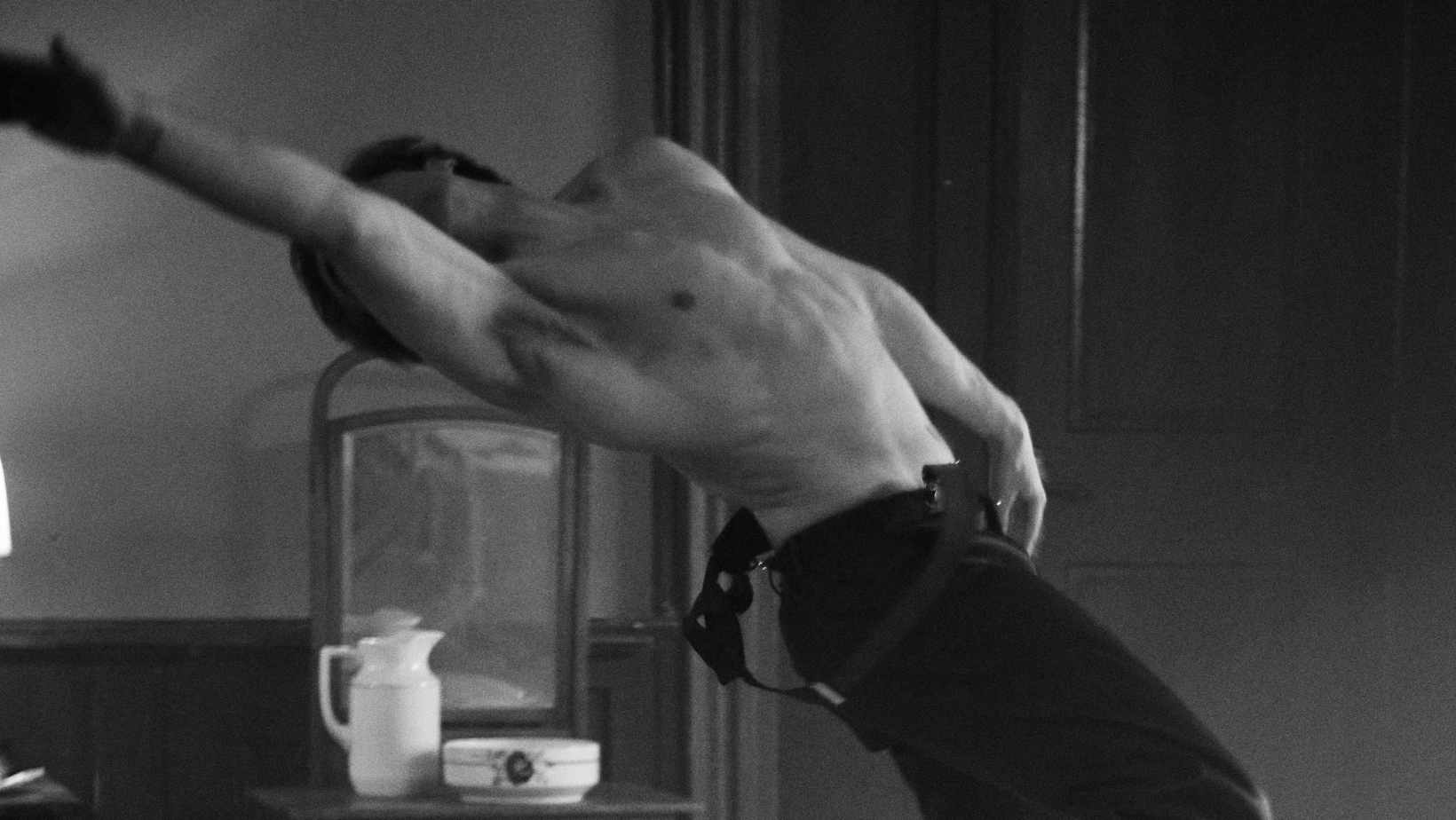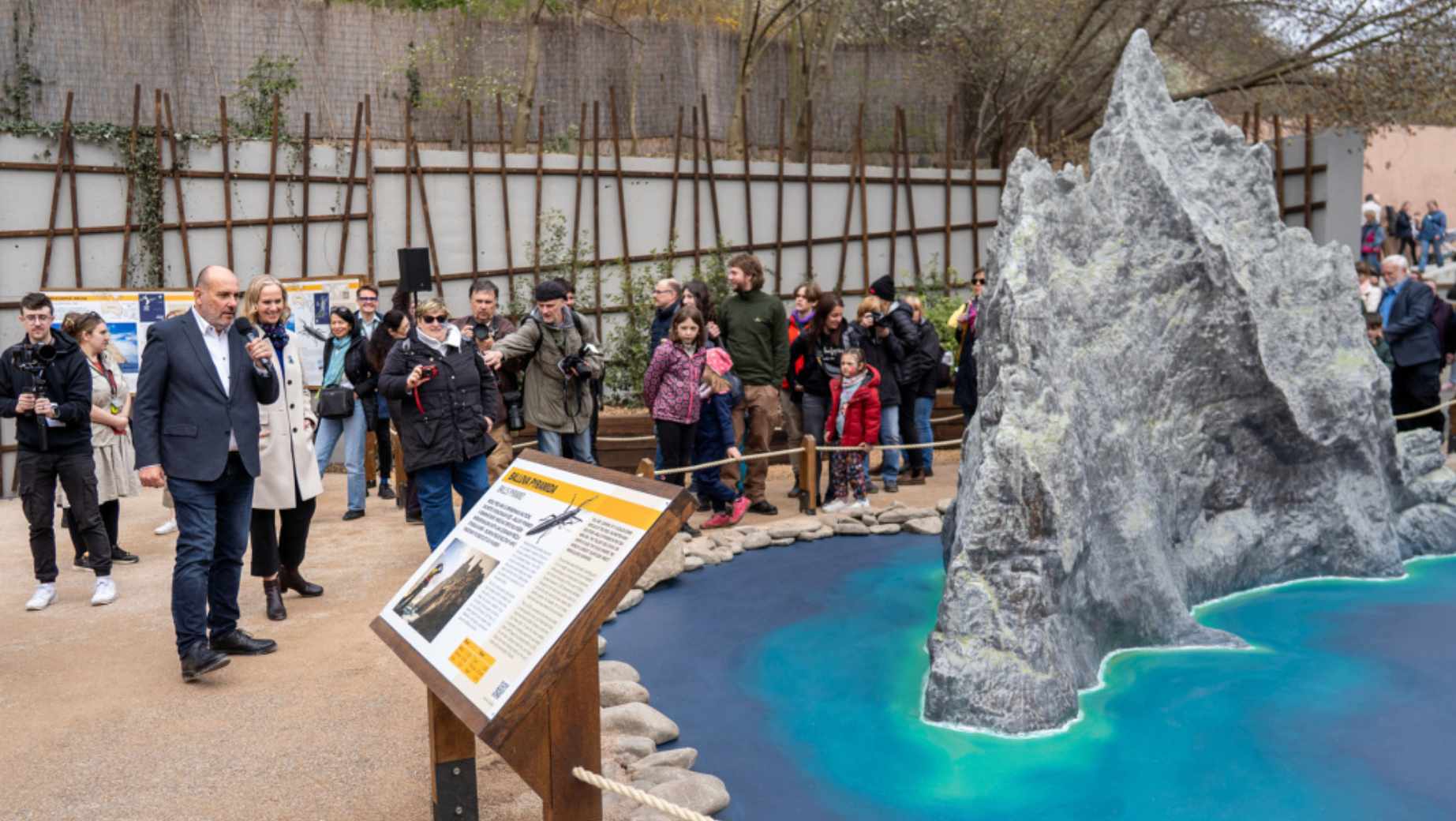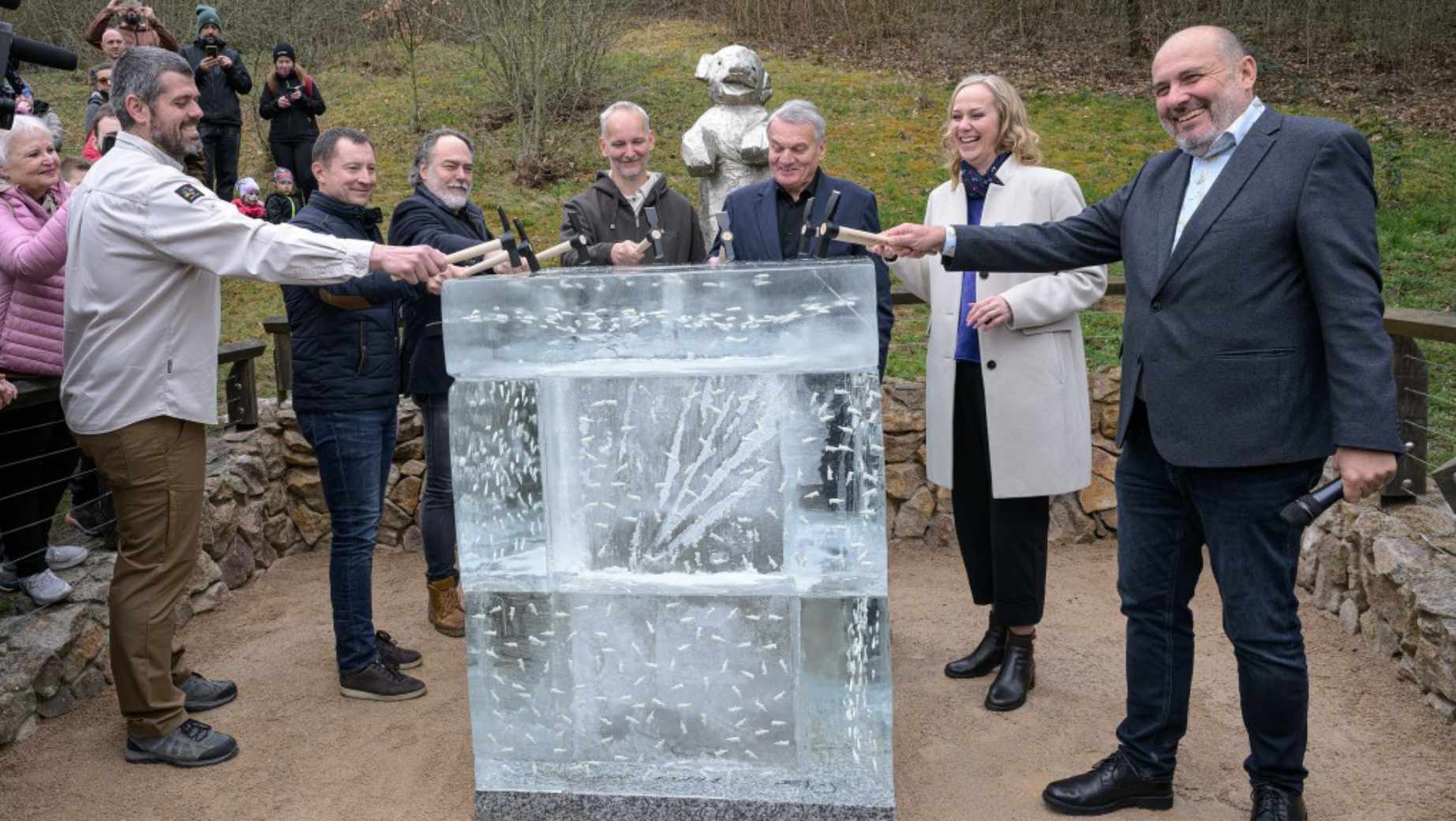For the past six years, the grand stages of Prague’s National Theatre have been graced by the precise, expressive movements of British-born dancer and choreographer Fraser Roach.
As a soloist with the Czech National Ballet, Fraser has been at the heart of the city’s vibrant dance scene, leading audiences through classical masterpieces and contemporary narratives.
Now, as he prepares to move on to Monte Carlo, he reflects on the winding journey that brought him here, and what it means to say goodbye to a city that has become, in his words, “very much like a huge part of me.”
Raised in England, Fraser’s pathway into ballet was anything but conventional. “I didn’t grow up knowing what ballet was,” he confesses. Coming from a family not mainly involved in the theatre arts, dance was not an obvious choice until a schoolteacher, Catherine Lynch, encouraged him to try ballet. “My mum told me I wouldn’t have to go again to make the teacher happy if I didn’t like it. I gave it a try… and then I just kept going.”
That one tentative step led Fraser to the Royal Ballet School, where he spent most of his formative years. Still a teenager, he left the institution early to take up a guest contract in Bordeaux, France, a leap that quickly transitioned into a permanent place in the company. From there, his career took him to Stuttgart Ballet in Germany, where he danced for three years and toured extensively globally, from Japan to Thailand.

It was during this time that Prague entered the frame. Having visited the Czech capital as a teenager, Fraser had already been struck by its unique atmosphere. “The city is one of a kind, mysterious, with all its winding streets and dark little corners,” he recalls. Fraser was intrigued when his director in Stuttgart, who had connections to the Czech National Ballet, spoke highly of the company “It was an easy decision, really. It’s rare to find both a great company and a beautiful city. In fact, it was the only place I auditioned when I decided to move on.”
Since arriving in Prague, Fraser has immersed himself in a “very hard-working” company culture. “We work six days a week and have done about 140 shows this season. We’ve travelled to Hong Kong, Germany, and performed 14 productions.” The pace is demanding. “More than most companies in the world”, but also deeply rewarding. “The people are lovely. Some of my closest friends are from the company. And being in Prague, you’re surrounded by creativity. You meet artists and creators from all over.”

The city’s historic stages, rich with artistic legacy, have provided more than just a platform; they’ve added soul to his performances. “The audiences here truly care about art. It’s not just transactional, it feels meaningful. That’s rare and really special.”
A few stand out among the many roles he’s taken on during his time here: “Petite Mort” by renowned Czech choreographer Jiří Kylián, Onegin by John Cranko, and Fly Paper Bird by Marco Goecke, one of the choreographers he has admired since childhood. “I’m drawn to works that challenge me mentally, not just physically,” he explains. “Pieces that push you to enter another mental space are what fascinates me.”
That appetite for challenge extends far beyond the theatre. “I like stepping out of my comfort zone,” he says. “If you don’t, you just stay the same. You look back years later and see no growth, no challenge. It’s uncomfortable at first, sure, but it’s always rewarding in the end, even if you feel like you’ve failed.”

Outside the spotlight, Fraser’s love for Prague is just as vivid. On his rare day off, he enjoys exploring the city’s parks and beer gardens during the warmer months or cosying up in local bars and restaurants during the winter. “In summer, I love being outside… In winter, the city is just magical.” He’s especially fond of trips to Český Krumlov and discovering new places whenever friends visit.
When it comes to local favourites, he doesn’t hesitate. “NOI has been my favourite since I arrived. They do amazing Thai food, and it’s the only place I’ve found where you can get really spicy food.” For cocktails, he heads to Café Pilotů. “It’s not snobby or fancy, just a warm, cosy place with people who care about what they’re doing.”
Having lived abroad since he was 17, Fraser speaks candidly about his shifting sense of home. “I always feel like a weird pariah when I return to England… even the language seems to have changed somehow.” Prague, by contrast, has given him a sense of belonging. “I definitely feel at home here.”
Still, after six seasons, a change is on the horizon. Fraser is preparing to relocate to Monte Carlo this August, drawn by the opportunity and, as he jokes, “some nice sunshine and beaches in the South of France.” He never expected to stay in Prague so long. “When I first came here, I thought I’d only stay for about two years. It’s been six. I usually find that when people come to Prague, it sucks them in.”

Before he leaves, he’s looking forward to the release of his latest creative project: “Boys A Bug”, a cinematic dance film based on Kafka’s The Metamorphosis. Created in collaboration with TED Talks, the piece explores physical transformation through movement and storytelling. “We called it a ‘movie-dance’, focusing more on storytelling than just the moves,” he explains. “The movement tells the story. I think it will be cool, and I’m excited for everyone to see it.”
As for advice to fellow expats or newcomers looking to move to Prague, Fraser keeps it simple: “Prague is so lovely. Everyone is kind, and it’s really easy to settle in. Prague is very international and welcoming, unlike some cities with many unwritten rules.” His only word of warning? “Maybe just avoid Wenceslas Square. It’s just… so touristy. Keep it local. Walk through Old Town Square if you must, but don’t pay €15–€20 for a beer.”
With a career defined by artistic risk-taking and an eye for beauty in the unexpected, Fraser Roach has not just danced through Prague, he’s lived it, loved it, and left his mark.
Would you like us to write about your business? Find out more
Czechia had delivered another 400,000 rounds of large-callibre ammunition to Ukraine by the end of April through its international initiative, Defence Minister Jana Černochová announced in Czech Television’s debate programme on Sunday.
Funding for the programme is secured until the autumn, she added.
The Czech Republic has so far invested one billion crowns in the initiative. Last year, with the support of its allies, it supplied Ukraine with approximately 1.5 million pieces of artillery ammunition of various calibres.
Černochová confirmed that one billion crowns had been allocated from the state budget but declined to provide additional details, citing security concerns related to military intelligence.
According to Černochová, new countries are joining the Czech ammunition initiative, with Belgium among those pledging participation. Czech Foreign Minister Jan Lipavský had earlier said Canada, Norway, Denmark, and the Netherlands provided new funding to support the effort.
Lipavský stated that the initiative significantly reduced Russia’s artillery advantage in Ukraine.
The Czech Republic aims to supply Ukraine with 125,000 rounds monthly throughout 2025.
When asked whether this year’s delivery totals will exceed last year’s figures, Černochová said she preferred not to tie herself to specific numbers.
She stressed that the initiative’s future will depend heavily on the success of ongoing fundraising efforts and international support.
Would you like us to write about your business? Find out more
Airbnb listings in Prague are bouncing back as travel restrictions ease, approaching levels not seen since before the pandemic.
But the resurgence has brought a new shift: the rise of professional property managers, raising fresh concerns about the impact of short-term lets on the city’s already strained housing market.
According to new figures from Prague’s Institute for Planning and Development (IPR), the number of active Airbnb listings has increased more than fivefold since hitting a low in 2021. While the platform hasn’t yet returned to pre-Covid levels, growth is steady. As of summer 2024, around 9,000 apartments were listed across the city.
From Spare Rooms to Full-Time Business
IPR data shows that around 3,000 Airbnb hosts operate in Prague. Yet two-thirds of them – so-called “single hosts” – control just 20% of the listings.
The bulk of Airbnb properties are now in the hands of hosts with multiple listings. In fact, hosts managing five or more units now account for more than half of all short-term rentals in the city.
“Airbnb has become increasingly commercial, and in Prague the trend is especially stark,” says Jan Sýkora, a housing analyst at IPR. “Back in 2019, the average host managed two properties. By 2024, it’s risen to three. This shows growing concentration among professional operators.”
These properties, Sýkora notes, no longer function as real homes. “They’re not lived in year-round. They’re purely short-term rentals.”
That shift is reflected in the rise of specialist property management companies. Zuzana Benešová, founder of Seven Keys, oversees short-term rentals in about 80 flats across Prague.
More Profit, Less Housing
The financial incentive for landlords to go short-term is clear. “Depending on the area, the net income from short-term rentals can be 30% to 50% higher than renting long-term,” says Benešová. That difference is pushing more landlords to exit the traditional rental market altogether.
Matěj Koutný, chair of the Czech Association of Landlords and Private Accommodation Providers (ČAPUS), argues the shift to professional management could raise standards. “It’s a natural evolution,” he says. “It no longer makes sense to rent just one apartment. Larger operators are more likely to comply with regulations and provide quality service.”
But not everyone agrees it’s a positive trend.
Zdeňka Havlová, head of analysis at IPR, warns that the expansion of short-term rentals is worsening housing affordability and fuelling over-tourism in already crowded districts.
“This makes life more difficult for residents,” she says. “It pushes up prices and shrinks the stock of long-term rental housing.”
Housing costs in Prague are already among the highest in Europe relative to income. According to the 2024 Deloitte Property Index, Prague is the second least affordable city on the continent – behind only Amsterdam.
While Airbnb operates city-wide, it remains heavily concentrated in the historic centre. In 2019, 44% of all listings were in Prague 1 and 2. In 2024, that figure has jumped to 56%.
Despite growing public concern, regulation has proven elusive.
Today, there’s no specialised law governing short-term rentals in the Czech Republic. Under current rules, properties used for tourist accommodation must be registered as such under the Building Act – but enforcement is practically non-existent. Inspections are rare, and authorities lack access to the data needed to track Airbnb activity.
Would you like us to write about your business? Find out more
Prague’s city centre is among the hottest areas in the Czech Republic.
Dense urban development, concrete pavements and asphalt surfaces have turned the capital into a heat island, where ground temperatures during summer can soar above 50°C—several dozen degrees higher than in areas where the soil can breathe and retain moisture.
These extreme conditions, intensified by climate change, underline the need for urgent, long-term solutions.
In response, the city has adopted the Strategy for Adaptation of the Capital City of Prague to Climate Change, a broad plan aimed at cooling the urban environment and strengthening resilience.
As part of its public outreach, Prague will host a Climate Walk on Thursday, April 10, highlighting specific projects already in place. The event is free and open to the public.
The programme begins at 1 p.m. at the European House (Národní 10), with an opening address followed by presentations from Prague City Hall officials. They will outline the goals of the Prague Climate Plan, provide updates on current initiatives, and share progress to date.
The first stop on the walk is Smetanovo nábřeží, a recently redesigned riverside street transformed with climate adaptation in mind. The project focused on improving pedestrian comfort with a wider promenade on both sides, a new cycle path, and tree-lined avenues offering shade during the hot summer months—a crucial upgrade in an area that sees up to 100,000 visitors daily during peak season.
The route will also take visitors through the area surrounding the National Museum, which has recently undergone major revitalisation. The ground between the museum and Čelakovský Park has been resurfaced with permeable paving stones to help absorb rainwater.
The park itself has been replanted with diverse vegetation to support biodiversity—featuring 21 tree species, around 100 shrubs, and more than 100,000 plants.
Investment and Inspiration
“Prague is quite ahead of the curve in adaptation measures,” said Tereza Líbová, head of environmental projects at Prague City Hall. “The city is investing significantly in efforts to tackle urban overheating, improve green spaces and water management, and plant new tree-lined streets. But most importantly, we want to showcase innovative solutions, engage the public and inspire further action.”
Martina Čížková, Czech ambassador for the European Climate Pact, believes Prague can serve as a model for other cities. “Designing climate-resilient cities is no longer optional—it’s essential,” she said. “I hope the climate walk will encourage more people to take an interest in these efforts, and to understand how they matter for our health, our environment, and our future.”
Climate-Resilient Trees
One of the key stops will be Strossmayerovo náměstí, where 17 Julian elm trees were planted late last year by the Technical Roads Administration (TSK). Selected for their durability and long lifespan, these trees are part of a broader strategy to make urban spaces more livable.
“Trees are the lungs of the city. They cool streets, offer shade, trap dust and exhaust fumes, retain water, and make public spaces more pleasant,” said Jan Čižinský, mayor of Prague 7. “We’re grateful for every tree added to the district.”
Event Details
-
Climate Walk
-
Date: Thursday, April 10
-
Start Time: 1:00 p.m.
-
Starting Point: European House, Národní 10
-
Admission: Free (registration required)
-
Highlights: Smetanovo nábřeží, Strossmayer Square, National Museum area
Would you like us to write about your business? Find out more
As housing costs in Prague continue to rise, policymakers are looking abroad for solutions.
Poland’s approach to residential development has emerged as a potential model, with significantly shorter approval processes and policies that encourage large-scale construction.
In Warsaw, developers can secure building permits in as little as six weeks, whereas in Prague, the process can take up to 13 years. Poland’s streamlined regulations and proactive government involvement have led to a substantial increase in housing supply, creating a competitive market that has kept property prices more affordable.
A key factor behind this success is the Lex Developer Law, which allows developers to build in restricted areas in exchange for investing in public infrastructure such as schools, nurseries, and transportation networks.
This policy has accelerated residential expansion while ensuring that new developments contribute to community needs.
The results are evident in Warsaw, where the housing market is thriving. Developers like the Czech Trigema led by Radek Menšík have praised Poland’s system for its efficiency and incentives.
According to project director Fialková, competition among developers is so intense that companies must actively attract buyers, keeping housing prices in check.
In contrast, the Czech real estate market remains plagued by bureaucratic delays and restrictive regulations. Apartment prices in Prague have soared, making homeownership increasingly unattainable for middle-class families.
While Warsaw’s housing remains within reach for a broader segment of the population, Prague’s slow approval process and regulatory obstacles continue to push prices higher.
Property prices in Czechia rose by 10.7% in 2023, sales up by 34%
Real estate prices in Czechia increased by an average of nearly 11 % in 2024, while property sales surged by 34%, and new developments saw a 51% rise, according to data from the Czech Banking Association and Flat Zone.
The market is rapidly returning to pre-crisis levels after a sharp downturn in 2022. Older apartment prices rose by 10% nationwide and 18% in Prague.
Would you like us to write about your business? Find out more
Prague Zoo has officially begun construction on a new Arctic pavilion, which will feature state-of-the-art enclosures for polar bears and harbour seals.
The project was announced by Pavel Brandl, curator of mammal breeding, on Saturday during the zoo’s 94th season opening. The event included a ceremonial laying of the foundation stone for the Arctic exhibition complex.
The pavilion will consist of three enclosures: one with a watercourse for polar bears and two for harbour seals. According to the zoo’s director, Miroslav Bobek, the facility will offer visitors a unique underwater view of the bears, enhancing the educational and observational experience.
Bobek emphasised that the new pavilion aligns with the latest research on polar bear care while continuing Prague Zoo’s long-standing tradition of breeding them. The zoo has housed polar bears since 1932 and achieved a world-first in 1942 with the successful artificial rearing of a cub.
Despite these milestones, breeding polar bears remains complex. Female bears sometimes reject or harm their young, and replicating their milk for artificial rearing poses a significant challenge.

The construction is expected to take around three years and cost 755 million CZK—well below the initial estimate of over one billion CZK.
Spanning 8,000 square meters in the zoo’s northwest section near Gočárový domů, the Arctic complex will include not only animal enclosures but also visitor-friendly spaces such as a restaurant and other facilities.
Alongside the Arctic pavilion announcement, Prague Zoo unveiled a new exhibit featuring critically endangered lobsters, named Ball’s Pyramid after the world’s tallest sea stack, where the species was discovered in the 1960s.

The zoo has also introduced an interactive programme for visitors, offering face painting at the Gočár Houses and Bororo Reservation, an Arctic-themed play area, and guided feeding sessions.
Guests can watch feedings of meerkats, ring-tailed lemurs, and South African sea lions, including their popular veterinary training demonstrations.
Would you like us to write about your business? Find out more
A new study has confirmed what many have already suspected—drug use in the Czech Republic is increasing.
According to wastewater analysis conducted by the TG Masaryk Water Research Institute (VÚV), cocaine is the most common drug in Prague and Pilsen.
At the same time, methamphetamine (pervitin) dominates in Ústí nad Labem and Ostrava. The study also found that marijuana use is rising, with its presence in public spaces becoming more visible, particularly in Prague.
Gone are the days when smoking a joint was done in secret; today, the scent of marijuana is replacing cigarette smoke on the streets of the capital. However, how do scientists identify which drugs are being consumed and where? The solution was discovered in the wastewater analysis—novel, anonymous, and highly accurate for gazing at national drug consumption patterns.
How Scientists Track Drug Use Through Wastewater
Each year, researchers take wastewater samples from large Czech cities and test them for traces of drugs. It is a straightforward, objective way to see what people are using. The data is then sent to the European Union Drugs Agency (EUDA), allowing comparisons with other countries.
“The method provides an objective and anonymous view of drug consumption in the population. Thanks to it, we know which substances are the most popular and where their use is most widespread,” explains Věra Očenášková, the project leader at VÚV.
However, why don’t scientists sample unknown wastewater in one day? The reason is that people’s behaviour is different during the week. Friday and Saturday nights are party nights, and Mondays are recovery and sleep days. Scientists sample wastewater throughout a week to determine the best estimate of drug use.
The collected samples are then analysed using a liquid chromatograph – a state-of-the-art device worth CZK 15 million.
This device can accurately detect what substances have flowed through the city’s sewers. One analysis takes about two hours and provides a detailed overview of the presence of various drugs.
Drug map of the Czech Republic
In Prague alone, several kilograms of cocaine are flushed down the drain every week—equivalent to hundreds of thousands of individual doses. Addiction specialist Michal Miovský believes this information is crucial for law enforcement and public health efforts.
“Based on this data, authorities can determine where drug trafficking is most active and where prevention efforts should be focused,” he explains.
Prague remains the epicentre of cocaine use, but high concentrations were also found in Pilsen, Brno, and České Budějovice.
Marijuana is the most prevalent and accepted substance in the Czech Republic. “Marijuana stays in the body for a long time, which is why its levels tend to be high in wastewater,” explains Kateřina Grohmannová from the National Drug Monitoring Centre.
The highest levels of marijuana use were recorded in České Budějovice, Pilsen, and Prague, though significant concentrations were also found in Brno, Karlovy Vary, Ostrava, and Ústí nad Labem. According to experts, marijuana popularity is universal among generations, with no change in consumption patterns over time.
Ketamine is increasing, particularly in Prague, Ústí nad Labem, Brno, and Pilsen. The increasing trend of ketamine is something to worry about because the abuse of the drug has severe health implications. The death of actor Matthew Perry, in which ketamine was involved, has put its risks in the spotlight again.
Pervitin: The Czech Republic’s Long-Standing Meth Problem
Pervitin has long been a significant issue in the Czech Republic. It remains most common in Ústí nad Labem and Ostrava, regions that face significant socio-economic difficulties. The drug’s low price and easy availability make it particularly appealing.
Three years ago, pervitin was even detected in wastewater samples taken from schools in the Chomutov region, indicating that children under the age of 15 are experimenting with the drug. The study also found high levels of pervitin use in Pilsen, České Budějovice, and Brno.
Ecstasy: The Weekend Party Drug
Ecstasy (MDMA) remains a favourite among partygoers, with the highest levels found in Prague and Ostrava, followed by Pilsen, Brno, and České Budějovice. Unlike other drugs, ecstasy use is seasonal and peaks on weekends, which is reflected in the wastewater data—concentrations of MDMA spike on Fridays and Saturdays, then drop significantly during the week.
Would you like us to write about your business? Find out more
Sport has the power to unite people, bridging cultures and fostering a sense of belonging. In Prague, one club is doing just that—Galaksia Praha 23.
Since its founding in June 2023, Galaksia Praha 23 has grown into a dynamic football community, bringing together players and coaches from more than 30 nationalities.
With over 60 active members, the club fosters inclusivity through a shared love of football, transcending borders and backgrounds.
One of its biggest achievements to date is securing a spot in the Czech League of Football for the 2025/2026 season, where it will compete from the 9th tier.
This marks a steady rise in the domestic football scene. Over the past two seasons in the Hanspaulka league, Galaksia has earned three promotions across two teams, underlining its competitive drive.
Beyond league success, the club has made waves in tournaments. It claimed victory at the 2024 Summer Soccer Festival in Brno and notched an impressive beach soccer win against a Sparta Prague side—clear signs of its growing influence in Czech football.
Expanding its reach beyond football, the club also offers weekly English-speaking 3×3 indoor basketball sessions on Wednesdays and Thursdays, welcoming players from all backgrounds. This initiative reflects Galaksia’s broader commitment to community engagement and diversity in sports.
Galaksia Praha 23 also partners with Bites of India, an Indian restaurant in Prague, reinforcing its multicultural ethos both on and off the field.
Actively recruiting new talent, the club holds trial sessions every two weeks for two players. A larger trial round is set for Saturday, May 10, at 14:00 at Stadion Na Pecích (FK Admira grounds), offering aspiring players a chance to be part of this growing football family.
More than just a club, Galaksia Praha 23 embodies the power of sport to unite people from all walks of life. To get involved, follow them on Instagram or Facebook.
Would you like us to write about your business? Find out more
A wave of new bone marrow donors has joined the Czech registry, moved by the story of two-year-old Madlenka.
Over the past ten days, more than 6,000 people have registered as bone marrow donors in Czechia—half the number usually recorded in an entire year.
In 2023, the total number of new donors was around 12,000, yet this unprecedented surge took place in just a few days, largely thanks to Madlenka’s father, who shared her story online.
Madlenka, a two-year-old girl, is battling aplastic anemia, a serious condition that affects bone marrow function.
Her search for a compatible donor has touched the hearts of thousands, prompting people across the country to sign up. Doctors and medical staff continue to process samples, including those sent from plasma centers and transfusion stations. The donor drive will run across Czechia until the end of April.
For those unable to donate due to age restrictions, there’s still a way to help. A fundraising campaign has been launched to cover the costs of donor registration and collection. As of Friday evening, donations had surpassed 850,000 CZK.
The surge in registrations has been visible across the country. In Brno alone, 580 people signed up yesterday.
Over the past weekend, long lines of volunteers formed outside Prague’s IKEM hospital, where on-site donor recruitment is ongoing until noon each weekday. Today, registration events are also taking place in Domažlice, Zlín, Brno, and Znojmo.
